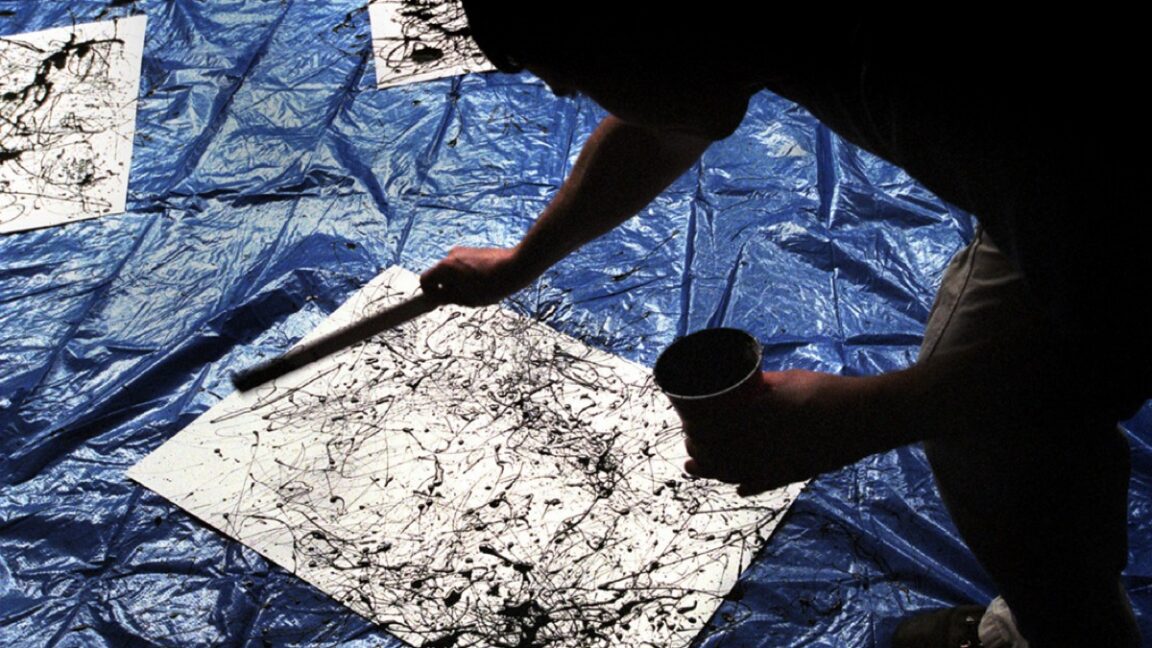Science
Study Reveals Children’s Paintings Resemble Pollock More Than Adults

Research has demonstrated that the drip paintings created by young children closely resemble the work of renowned abstract artist Jackson Pollock, more so than those produced by adults. This surprising finding stems from a recent study published in the journal Frontiers in Physics, which analyzed the fractal patterns in splatter paintings by both demographics. The study highlights the unique physiological attributes of children, suggesting that their balance and movement contribute to a distinctive artistic style.
The co-author of the study, Richard Taylor, a physicist at the University of Oregon, has a history of investigating Pollock’s techniques. His earlier work revealed fractal patterns in Pollock’s paintings, leading to significant debate among art historians and physicists alike. In 2001, Taylor’s initial hypothesis about the fractal nature of Pollock’s art was met with skepticism, particularly from Katherine Jones-Smith and Harsh Mathur at Case University, who criticized the methodology used in his analysis.
Despite facing criticism, Taylor’s work gained traction when a 2015 machine learning study achieved a remarkable 93 percent accuracy rate in distinguishing authentic Pollock pieces from forgeries based on fractal dimension and other factors. Building on this, Taylor’s latest research reports an impressive 99 percent accuracy in a subsequent study.
The analysis of Pollock’s artistic process has also explored the underlying physics of his techniques. For instance, a 2011 article in Physics Today examined Pollock’s method of using “coiling instability” in his paintings. This concept describes how fluids behave when poured, producing diverse patterns based on viscosity and movement speed. Discussions regarding Pollock’s intentional use of these principles remain contentious, as later studies suggested he may have deliberately avoided certain fluid dynamics.
Taylor’s current investigation utilized a practical setup involving “Dripfests,” community events where participants, including children and adults, create their own Pollock-like artworks. The study involved 18 children aged four to six and 34 adults aged 18 to 25, allowing for a clear comparison between different stages of biomechanical balance development.
The researchers not only analyzed the fractal dimensions of the resulting artwork but also examined a metric known as “lacunarity,” which assesses the distribution of gaps between paint clusters. The results revealed that adult paintings exhibited higher paint densities and varied paint trajectories, while children’s artworks showcased simpler patterns and larger gaps.
“This indicates that while both groups exhibit coarse-scale motions, the fine-scale structures differ significantly,” Taylor explained. “The children’s paintings had less fine structure, and what they did have was clumpy, contrasting with the adults’ uniform fine structures.”
In a noteworthy extension of the study, Taylor and his colleagues compared the findings to Pollock’s famous work, Number 14, and Max Ernst‘s Young Man Intrigued by the Flight of a Non-Euclidean Fly. Ernst’s use of a controlled pendulum for his art yielded fractal dimensions within the range of the children’s paintings, further supporting Taylor’s hypothesis about the relationship between balance and artistic expression.
Looking ahead, Taylor acknowledges the limitations of the current study, particularly the lack of direct measurements of biomechanical balance during the painting process. Future Dripfests will incorporate motion sensors to collect data on participants’ movements, enabling a more comprehensive analysis of how balance impacts artistic output.
This research not only highlights the intricate relationship between physiology and creativity but also opens new avenues for understanding how various artists, including Pollock, utilized the principles of physics to shape their work. The findings encourage an appreciation for the unique artistic expressions that can emerge from the physical limitations of the human body, emphasizing that even clumsiness can yield profound beauty in art.
-

 Politics2 weeks ago
Politics2 weeks agoSecwepemc First Nation Seeks Aboriginal Title Over Kamloops Area
-

 World4 months ago
World4 months agoScientists Unearth Ancient Antarctic Ice to Unlock Climate Secrets
-

 Entertainment4 months ago
Entertainment4 months agoTrump and McCormick to Announce $70 Billion Energy Investments
-

 Lifestyle4 months ago
Lifestyle4 months agoTransLink Launches Food Truck Program to Boost Revenue in Vancouver
-

 Science4 months ago
Science4 months agoFour Astronauts Return to Earth After International Space Station Mission
-

 Technology3 months ago
Technology3 months agoApple Notes Enhances Functionality with Markdown Support in macOS 26
-

 Top Stories1 month ago
Top Stories1 month agoUrgent Update: Fatal Crash on Highway 99 Claims Life of Pitt Meadows Man
-

 Sports4 months ago
Sports4 months agoSearch Underway for Missing Hunter Amid Hokkaido Bear Emergency
-

 Politics3 months ago
Politics3 months agoUkrainian Tennis Star Elina Svitolina Faces Death Threats Online
-

 Politics4 months ago
Politics4 months agoCarney Engages First Nations Leaders at Development Law Summit
-

 Technology4 months ago
Technology4 months agoFrosthaven Launches Early Access on July 31, 2025
-

 Lifestyle2 months ago
Lifestyle2 months agoManitoba’s Burger Champion Shines Again Amid Dining Innovations











